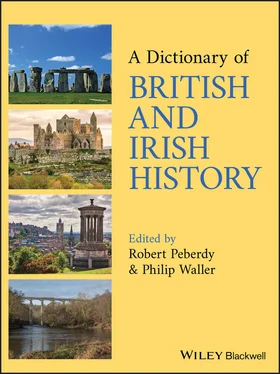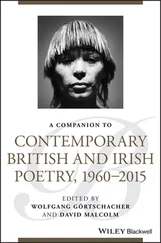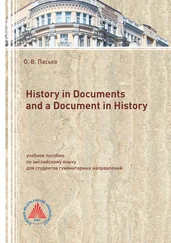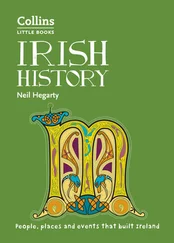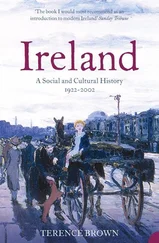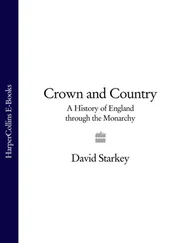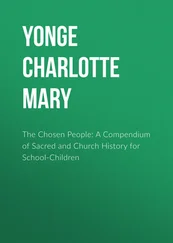In England, struggles 1258–67 between King HENRY III and BARONS alienated by Henry’s reckless foreign policy, oppressive government and favouring of foreign relatives.
On 30 April 1258, after Henry had supported a relative in a dispute against a baron, leading nobles demanded reform of government ( see LUSIGNANS). In June Henry accepted, by oath, the Provisions of OXFORD which subordinated his government to an elected Council and required co‐operation with PARLIAMENT. The reforms were extended in Oct. by the Provisions of WESTMINSTER. The Council collapsed in late 1260, enabling Henry to regain authority (e.g., appointing supporters to offices). On 12 June 1261 a papal bull was published which released Henry from his oath, causing the reformer Simon de MONTFORT to go abroad (July).
In 1263 Montfort returned (April), and reformers attacked royalists’ estates. The Provisions of Oxford were reimposed (16 July), with Montfort dominating government. During the summer, some reformers (e.g., Roger BIGOD) changed sides. On 1 Nov. a truce was agreed and Louis IX of France was asked to arbitrate. He condemned the reformers (Mise of Amiens, 23 Jan. 1264), yet opposition continued. On 14 May, at the battle of Lewes (Sussex), reformers captured Henry and his heir Edward. Montfort effectively ruled in the king’s name, looking to Parliament for support.
In 1265 Edward escaped (May), rallied support and defeated opponents at Evesham, Worcs. (4 Aug). Montfort was killed. Henry conciliated opponents with moderate reforms and land restitution ( see KENILWORTH, DICTUM OF), though fighting continued until July 1267.
BARONY, IRELAND
Name used from the 16th century for subdivisions of SHIRES (or counties), totalling about 250. They are based on the Gaelic Irish unit the trícha cét (meaning ‘thirty hundred’), which refers to military musters and is recorded as a territorial unit from the 11th century. It has been suggested that most of the territories represent the areas of small kingdoms ( see TÚATH ).
After the Anglo‐Norman invasion (1169–70), the trícha cét was equated with the Welsh CANTREF. From the late 17th to 19th centuries baronies were important in county‐based government – used for assessing public works and levying CESS. In 1715 the Irish Parliament authorized the appointment of constables for baronies. See also LOCAL GOVERNMENTAL STRUCTURES, IRELAND.
BARONY, SCOTLAND
A basic unit of local (judicial) administration from the 13th century to the 18th; until the later 15th century, most were roughly equivalent to parishes, and probably contained a dozen or so FERMTOUNS. Many were continuations of early THANAGES and 12th‐century knights' fees.
Formal development into baronies resulted from royal grants of judicial powers (over, e.g., theft, assault, accidental homicide). There were over 400 baronies c .1400, and more than 1000 in the 17th century. Barons' powers were reduced in the 1650s, and although they were not abolished by the Heritable Jurisdictions Act (1747), they fell into disuse. See also LOCAL GOVERNMENTAL STRUCTURES, SCOTLAND; LAIRD.
BARTHOLOMEW’S DAY EVICTIONSIn England and Wales, 1662, following RESTORATION of the monarchy, the resignation of about 1000 clergy from their Church of ENGLAND livings for rejecting the Church’s ceremonies as prescribed in the newly revised PRAYER BOOK. Under the 1662 Act of Uniformity, clergy were required to accept the book by oath, and renounce the SOLEMN LEAGUE AND COVENANT (1643), by St Bartholomew’s Day (24 Aug.), when TITHES were payable. The eviction of so‐called ‘Bartholomew men’ strengthened NONCONFORMITY. See also CLARENDON CODE. BASTARD FEUDALISM
Term invented in 1885 by the English historian Charles Plummer to describe lordship and political society in late‐medieval England (14th–15th centuries). It described a situation in which lords obtained services and military support by recruiting and retaining followers mainly with money payments (instead of with land, as in a ‘traditional’ feudal system; see MILITARY SERVICE, ENGLAND 1066 TO MID 17TH CENTURY). Payments were made as either annual fees (annuities) or daily wages, and were sometimes agreed by contract (or indenture). Lords also provided uniforms or other insignia and food (so‐called ‘livery and maintenance’). Uniforms and insignia indicated allegiance. The ‘retaining’ of GENTRY and others provided magnates with ‘retinues’ (effectively private armies) which they could use for feuding, influencing legal proceedings and warfare. A lord’s total body of followers was called an ‘affinity’.
Bastard feudalism has a longer and wider history than Plummer envisaged, and political society was arguably more fluid, and less contractual. Retaining existed by the mid 12th century though it grew during the 14th century. The House of Commons complained about its effects (e.g., lawlessness) from the 1370s onwards, and bastard feudalism facilitated the YORKIST–LANCASTRIAN CONFLICT (1450s–80s). Similar developments occurred in Wales and parts of Ireland, and to a lesser extent in Scotland ( see MANRENT).
From the late 13th century, English rulers relied on retinues recruited by noblemen to provide military forces, but in the late 15th and 16th centuries they sought to control retaining. It remained a means of raising armed forces for the Crown until the CIVIL WARS (1640s), although its importance declined in the later 16th century with the revival and development of the MILITIA. See also PATRONAGE.
BATH
A city in SW England, by the R. Avon; centre of Bath and North East Somerset (unitary authority). Site of natural hot springs.
Bath flourished as a spa under the Romans (1st–4th centuries; called Aquae Sulis, meaning ‘Springs of Sulis’), then declined in the 5th century. The site was taken by the Gewisse in the late 6th century ( see WESSEX), and named after the ruins of Roman baths. A MINSTER was founded in the late 7th century, and a small town later developed. Bath was a bishop’s see 1088–1206 and a joint see thereafter (with Wells, Somerset).
In the 18th century Bath became England’s premier spa and pleasure capital, over which Beau Nash (1674–1762) presided. Splendid houses, streets, squares, crescents and facilities (e.g., pump house) were built. After bombing in WORLD WAR II, buildings were subsequently restored. Bath gained two universities: Bath University of Technology (chartered 1966), Bath Spa University (upgraded college, 2005). See also EDGAR; TOWN PLANNING; CONSUMER REVOLUTION; HIGHER EDUCATION, EXPANSION OF.
Est. popn: 1086, 1500; 1300, 1500; 1600, 2000; 1800, 35,000; 1900, 52,000; 2000, 83,000.
BATH, EARL OFsee PULTENEY, WILLIAM BAXTER, RICHARD
(b. 12 Nov. 1615 at Rowton, Shropshire, England; d. 8 Dec. 1691 at London, England, aged 76). A Church of ENGLAND clergyman from 1638, with PURITAN sympathies, Baxter served as a preacher in Kidderminster (Worcestershire) 1641–2, and as a chaplain in Parliament’s NEW MODEL ARMY 1645–7. He returned to Kidderminster in 1648 as vicar. He became well known in the 1650s for his writings (notably The Saint’s Everlasting Rest , 1650), and in 1652 founded the Worcestershire Voluntary Association of Ministers to encourage unity.
After the RESTORATION (1660), Baxter declined the offer of a bishopric from King CHARLES II. He participated in discussions towards a Church settlement encompassing a broad range of Protestants ( see WORCESTER HOUSE DECLARATION; SAVOY CONFERENCE). When these failed, he left his living (1662). Thereafter he devoted himself to writing and preaching.
Читать дальше
